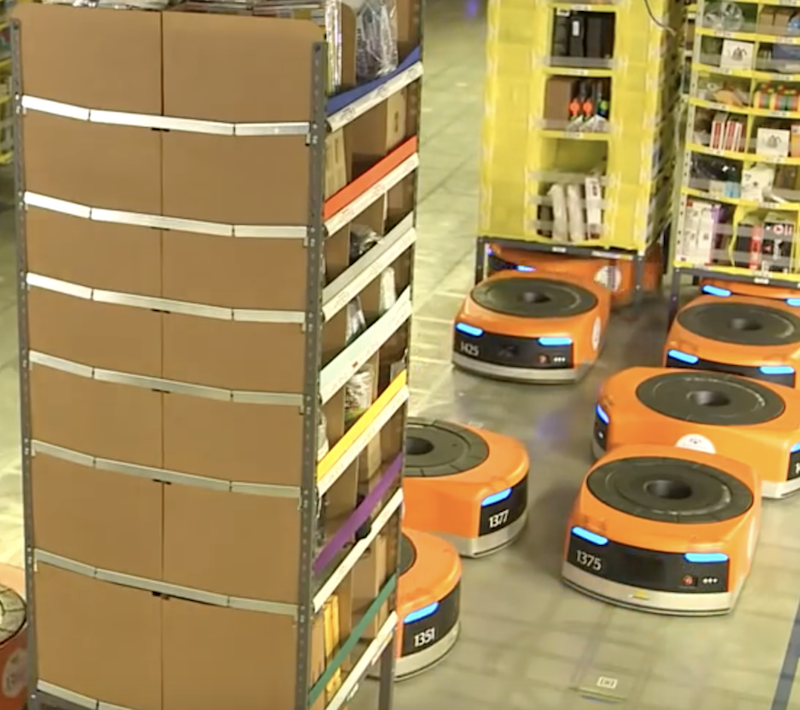Machine learning is enabling a new era of warehouse automation, as operators test artificial-intelligence-powered robots to help speed e-commerce orders.
An article posted earlier this week in the Wall Street Journal’s WSJ Pro section examines how logistics providers and retailers are deploying robotics to limit the number of steps their warehouse workers take and to execute more nuanced tasks long thought to be possible only by human hands.
Most warehouses still rely on human labor. But with the need to fill accelerating online orders, operators are looking for new, more efficient ways to manage distribution. Enter robotics: ROBO Global, a research and investment advisor, estimates that annual spending for warehouse and logistics automation, now at $46 billion, could surpass $75 billion by 2022.
Some examples of where the market may be headed, according to WSP Pro:
• XPO Logistics, with 1,529 locations and over 98,000 workers worldwide, is rolling out 5,000 AI-equipped robots that can deliver shelves full of products to workers.
• Rakuten Super Logistics—a division of the Japan-based online retailer Rakuten, with fulfillment centers in eight U.S. cities—is using robots to deliver bins full of products to workers who pick individual items for delivery.
• So-called collaborative robots that work in tandem with humans are also gaining popularity among warehouse operators, especially to manage seasonal workflows. XPO is using these robots to help guide workers through warehouse aisles, lighting up when they reach the next item to pick. Rakuten Super Logistics began using 40 “cobots” at its Las Vegas warehouse before the recent Christmas rush, and found they could handle increases in volume without adding temporary help.
Related Stories
| Jun 30, 2014
Research finds continued growth of design-build throughout United States
New research findings indicate that for the first time more than half of projects above $10 million are being completed through design-build project delivery.
Sponsored | | Jun 27, 2014
SAFTI FIRST Now Offers GPX Framing with Sunshade Connectors
For the Doolittle Maintenance Facility, SAFTI FIRST provided 60 minute, fire resistive wall openings in the exterior using SuperLite II-XL 60 insulated with low-e glazing in GPX Framing with a clear anodized finish.
| Jun 18, 2014
Arup uses 3D printing to fabricate one-of-a-kind structural steel components
The firm's research shows that 3D printing has the potential to reduce costs, cut waste, and slash the carbon footprint of the construction sector.
| Jun 12, 2014
Austrian university develops 'inflatable' concrete dome method
Constructing a concrete dome is a costly process, but this may change soon. A team from the Vienna University of Technology has developed a method that allows concrete domes to form with the use of air and steel cables instead of expensive, timber supporting structures.
| May 29, 2014
7 cost-effective ways to make U.S. infrastructure more resilient
Moving critical elements to higher ground and designing for longer lifespans are just some of the ways cities and governments can make infrastructure more resilient to natural disasters and climate change, writes Richard Cavallaro, President of Skanska USA Civil.
| May 22, 2014
Facebook, Telus push the limits of energy efficiency with new data centers
Building Teams are employing a range of creative solutions—from evaporative cooling to novel hot/cold-aisle configurations to heat recovery schemes—in an effort to slash energy and water demand.
| May 22, 2014
Big Data meets data centers – What the coming DCIM boom means to owners and Building Teams
The demand for sophisticated facility monitoring solutions has spurred a new market segment—data center infrastructure management (DCIM)—that is likely to impact the way data center projects are planned, designed, built, and operated.
| May 20, 2014
Kinetic Architecture: New book explores innovations in active façades
The book, co-authored by Arup's Russell Fortmeyer, illustrates the various ways architects, consultants, and engineers approach energy and comfort by manipulating air, water, and light through the layers of passive and active building envelope systems.
| May 19, 2014
What can architects learn from nature’s 3.8 billion years of experience?
In a new report, HOK and Biomimicry 3.8 partnered to study how lessons from the temperate broadleaf forest biome, which houses many of the world’s largest population centers, can inform the design of the built environment.
| May 13, 2014
19 industry groups team to promote resilient planning and building materials
The industry associations, with more than 700,000 members generating almost $1 trillion in GDP, have issued a joint statement on resilience, pushing design and building solutions for disaster mitigation.

















